If you reside in an apartment or house, or you just need to ensure that your house is free of EMFs There are plenty of methods to reduce exposure. One of the most effective is to limit your electronic device use. emf blocking could also consider EMF blocker paint to block EMF radiation from entering your house. Another way to shield your home from EMF radiation is to install an RF shielding canopy. emf blocking is a cloth made of net which contains EMF shielding and is used to block EMFs from entering a room. Another option is to have your home fitted with a conductive enclosure. These devices are called Faraday cages.

Numerous studies have demonstrated how the non-ionizing energy of RF produces antiproliferative effects in HCC cells. The mechanism that drives AM RF EMF's anticancer activity in vitro is believed involve down-regulation the cancer stem cell. This could explain the long-term responses seen in some patients with advanced HCC. However, the mechanism behind AM RF EMF's effect in cancer patients is not evident.
The effects from AM RF EMFs on HCC tumour growth in vivo were examined in mice. The tumors were split into three groups. First, the group that was unaffected RF EMF. Another group of participants was subjected RF EMF at a frequency that is similar to the frequency used by humans. block emf was exposed to RF EMF with HCC-specific modulation frequencies. The effect of HCCMF on tumours was compared to that of RCF. The results revealed that cancers treated with HCCMF were significantly shrinking. However, tumours treated with RCF did not show any evidence of shrinkage in the tumour.
The mechanism of tumour-specific AM RF EMF might be due to the fact that cancer cells require Cav3*2 type voltage calcium channels for proliferation and down-regulation. AM RF EMF's ability to inhibit proliferation on HCC cells is controlled by CACNA1H the protein that regulates the Ca2+ influx specific to tumors. The results indicate that CACNA1H could have more broader implications for treatment and diagnosis of many cancers.
The tumors in those in the group that were unaffected to EMF from radiofrequency, and fed a normal mouse diet. The tumors in those in the HCCMF group were injected with Huh7 cells when they were five-seven weeks old. The tumours were then euthanized in cases of excessive burden.
The tumours in the three groups also showed distinct growth curves. The HCCMF-treated tumors had a significant reduction in tumour size after 8 weeks. However, the tumours treated with RCF did not show any signs of shrinkage. The difference was highly significant. The tumours treated with RCF had necrosis, which is common in tumours exposed to RCF. The possibility is that this necrosis was due to an absence of oxygen in larger tumors.
In sum, the results indicate that AM RF EMF is a powerful source of anticancer effects in vitro and in live. A number of studies have proven the fact that AM RF EMF produces measurable tumour shrinkage for HCC patients. There is a possibility that AM RF EMF triggers these effects because of CACNA1H, a protein that is involved in the process of tissue-specific Ca2+ influx. Additionally, AM RF EMF may exert a sustained effect on the growth of HCC tumours in vivo.
